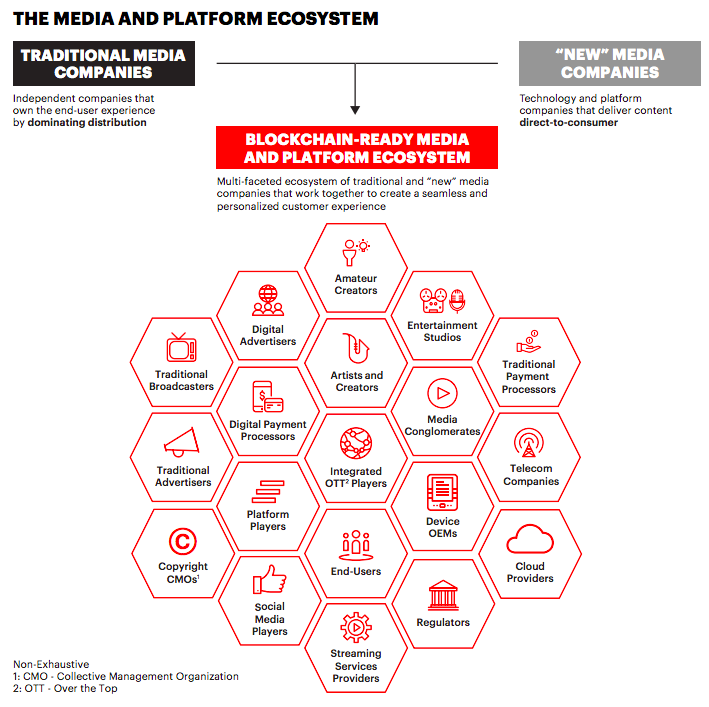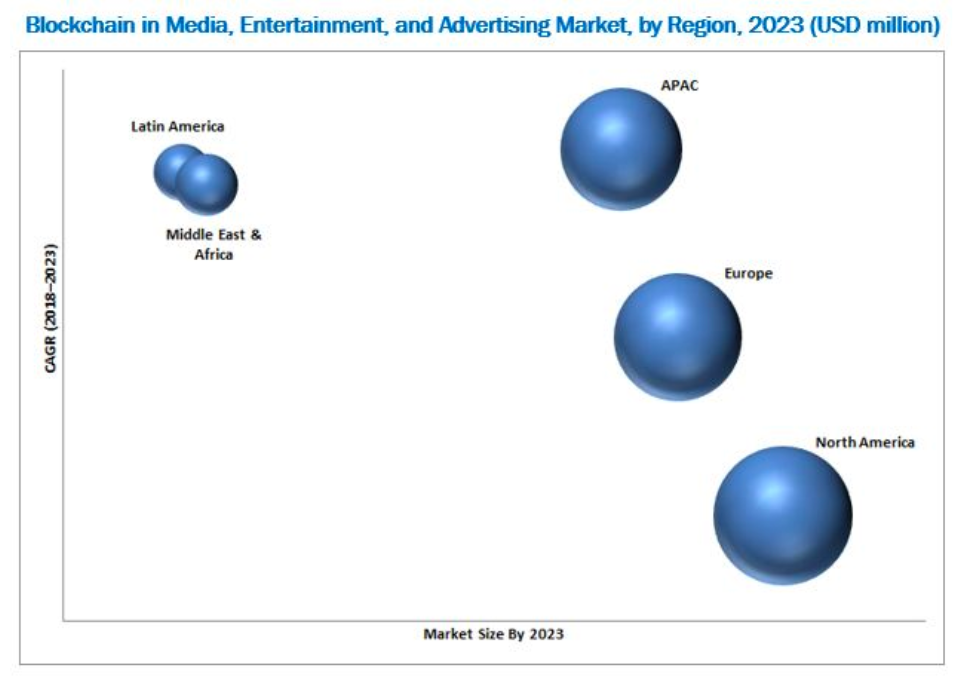Whether it is the movies or the virtual reality distribution platforms, media is embracing the decentralisation. Director Jeremy Culver’s No Postage Necessary, a romantic indie comedy, became the first film to be released with the help of blockchain technology. It allowed the viewers to purchase the movie through a blockchain-based video application Vevue and pay for it with the app’s digital currency.

In the media and entertainment industry, sharing a single, immutable set of records can metamorphose a wide array of contexts from content dissemination to advertising. Blockchain can enable seamless transactions with the coexistence of data between several parties with all of them having controlled access to a single, shared source of the truth. A tremendous amount of transparency, more precise payments, more circumstantial understanding of audiences for particular content, and more efficacious targeting of advertising are some of the merits of the blockchain.
Industry trends
Let’s start off by understanding blockchain briefly. It is a permissioned, immutable and distributed ledger. It creates a shared system of record among the members thereby removing the need for reconciliation of disparate ledgers. Each of the members should have access privileges and the information is shared only on a need-to-know basis. A consensus is required from each of the members and the validated transactions are permanently recorded that can’t even be deleted by the system administrator.
Blockchain is a permissioned , immutable and distributed ledger.
Accenture, in a report, suggests that if the media and publishing organisations reap the merits of the blockchain, they can capitalise on three major industry trends:
- The first of these trends is the strategic co-opetition that is mutually beneficial collaboration among competitors. Consumers’ ever-growing hunger of content had led media and publishing firms to focus more on collaborating and sharing tangible assets such as content and software and intangible assets such as data and consumer relationships. Blockchain-powered ecosystems offer shared visibility that enables partners to work together and operate from a single source of truth.

- Another trend is the creation of new value for consumers that can be addressed by blockchain. The granular, validated data captured by blockchain can be hugely beneficial for creating an astronomical level of personalised engagement (for instance, understanding of consumers at a psychographic level and demographic level) and enhance insights for integral business decisions (for instance, optimisation of promotional campaign investments and enhancing attribution models).
- The third one is the data security and blockchain’s capability of securing data is tremendous. Blockchain technology is touted to be an instrumental force when it comes to security as it creates an auditable and tamper-evident history of an asset whether it a device or content.
Implementation scenarios
Following are some of the blockchain-based use cases:
Paid content
Micropayments, powered by blockchain, can help publishers to monetise the individual articles or other pieces of content that could be sold for a certain amount without disproportionate transaction costs.
For instance, this can be advantageous and lead to an increased willingness to pay a few bucks for a music track instead of charging for a monthly subscription. Also, there is more precision in copyright tracking, allocation to media copyright holders and distribution of royalty payments thereby enhancing the efficacy.
Challenges can be with the huge transaction quantity and inevitable initial user registration.
Advertising revenues
With blockchain, everyone ranging from media houses to the bloggers can easily generate advertising revenues. Blockchain helps in tracking the exact content usage that allows direct allocation of advertising budgets.
This is beneficial as blockchain allows, for instance, direct customer relationships between fans and artists and the marketing performance and impact turns more precisely measurable. Also, the existing intricate media and advertising become streamlined and transparent.
Obstacles can be that content aggregators and advertising networks may lose their pre-eminence of market position in the media world.
Transparent royalty distribution
Blockchain can make royalty distribution more efficacious and transparent. For instance, this would comprise of a music directory with the original digital music file linked with all relevant identities of people who are part of content creation.
It is meritorious for near real-time and exact allocation and distribution of royalty payments as per usage based on smart contracts. It also brings in cost-effectiveness.
The problem may arise because of enormous amounts of historical data that is to be retained at the blockchain nodes.
Consumer-to-Consumer sales
The blockchain is a great solution for content rights owners for permitting additional revenue streams by leveraging consumer-to-consumer sales. Content owners have complete freedom of controlling and monetising all copyright assets that are recorded in the blockchain. To add to this, it does not allow illegal file sharing and other copyright infringements. Moreover, consumers do not have to spend monthly up-front fee and only the exact usage will be considered for billing.
Although media aggregators like television players and music streaming providers play a significant role in the marketing of contents, blockchain’s ability of democratisation of content may lead to the shifting of aggregator’s role towards curated discovery platforms for finding new content as monetisation and real-time billing will be offered to content owners through blockchain.
Paid content subscription
It can be a tremendous solution for making Digital Rights Management (DRM) systems obsolete or at least minimise the intricacy of these systems as every transaction is tracked and directly associated with a user. The payment can be automatically done as per the underlying smart contract terms for the content. This leads to an enhanced customer experience via boundless subscription models across different geographic areas.
But, it may be considered that the metamorphosis from the existing DRM and billing systems towards multi-country access and integration of blockchain functionalities is an intricate process.
Blockchain-based solutions in media
Currently, the media industry is being shaped by centralised firms censoring a superabundance of contents on one side of the spectrum and a humongous flow of low-quality user-generated content on the other side of the spectrum. A dangerous over-centralisation persists on a market share where illicit remunerations and poor customer experience are perpetually on the rise with a gigantic share of the wealth generated being seized by intermediaries. A plentitude of blockchain-based solutions has sprouted up in the media industry.
For instance, as a non-profit, distributed media platform, PUBLIQ Foundation provides a new publishing and rewards model where the wealth generated is transparent and entirely redistributed to the participants on the basis of their reputation and/or involvements. Every single post, views and feedbacks are recorded. The reputation (PUBLIQ Score) earned by authors is transparent and measured by a proprietary formula. Furthermore, a mechanism of community governance is in place that ensures that the readers are safeguarded from unwanted contents. Also, with the help of a proprietary artificial intelligence (AI) algorithm, that ensures top-notch optimised placements, direct and frictionless access to offered to the advertisers to place their ads.
Powered by smart media token, Steem offers a blogging platform where the content producers are paid.
An organisation called po.et is emphasising on handling the rights to a specific piece of content to make sure that publishers revel in a secure chain of delivery of the content. It has a token system giving it a marketplace for information. It can be used, for instance, to have a website that dynamically develops content on the basis of who the user is and pay only for those articles that are actually being displayed to the user. As the user clicks on the site, that payment is directly issued.
Also, DECENT is a startup that has the objective of developing a decentralised, safe and auditable platform for publishers in order to distribute their content globally and permitting them to bring content directly to the consumer.
Verasity has built a blockchain platform for weeding out bogus news content. This content-sharing platform powered by VERA tokens can be bought with Bitcoin and Ethereum and pays both viewers and creators for content. Consumers pay their favourite creator for producing material and get paid in return for investing as the channel gets more views and also get paid by the advertisers for viewing advertisements in lieu of having advertisers pay content creators for linking ads to content. Also, content viewers can choose if they want to share personal data and how much they wish to make public.
By applying blockchain-based imperceptible watermarking technology, Custos Media tracks the spread of digital media assets like movies and ebooks thereby increasing security and combating piracy.
Ara, a blockchain-based platform, is designed to offer creators and artists more authority over their content. It aims at decentralising ownership of content and leveraging tokens to authenticate transactions between publishers and consumers.
FilmChain is a collection service for allocation and assessing revenues for all participants who have invested in a film constituting producers, financiers, sales agents, cast and crew.
As a fair-trade music distribution platform, Mycelia aims to sidestep intermediaries like Spotify and record labels to permit fans to pay the musicians directly for their work with the help of cryptocurrencies.
Lucidity tracks ad impressions for reducing fraud and enhancing ad effectiveness across the intricate programmatic advertising supply chain.
Future of Blockchain in media

A report on MarketsandMarkets forecasts that the global market for blockchain in media, advertising and entertainment to grow at a Compound Annual Growth Rate (CAGR) of 81.1% between 2018 to 2023. That means, from USD 51.4 million in 2018, it will reach a whopping USD 1,000.1 million by 2023. The greater demand for mitigating intermediaries between content creators and end-users, the data piracy concerns and safe and quicker transactions of blockchain are expected to be a huge factor for driving this market.
Small and medium-sized enterprises are expected to grow faster in the forecast period. North America is expected to have the lion’s share of this market and the Asia-Pacific region will grow at the highest CAGR.
Conclusion
Even though blockchain technology is still in its early stages, vendor solutions are maturing and the organisations have already started implementing and using it for building distributed trust and establishing digital business ecosystems. Blockchain promises to be a huge solution for many of the media and publishing’s present-day challenges.
We are in the constant pursuit of embracing futuristic technologies like blockchain and have been offering digital innovation solutions with our suite of services.
Contact us at [email protected] and let us know how can we help your organisation leverage blockchain for building futuristic solutions.
Subscribe
Related Blogs
Why should you prioritize lean digital in your company?

We are living in an era where the change and innovation rate is just so high. If you want your organization to reach new…
How to measure your open source program’s success?

Along with active participation, it is very important to look after the ROI of open-source projects, programs, and…
Understanding the significance of participating in open-source communities

Do you think contributing to the open source community can be difficult? I don’t think so. Do you have to be employed by a…



